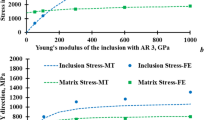Summary
This paper concerns the effects that slight deviations in fiber directions have on the stress field in composite plates. The fiber reinforced plates are represented by the equivalent modulus theory as homogeneous transversely isotropic regions and the deviations in fiber directions are incorporated by varying the directions of the axes of the material symmetry.
Solutions are presented to three specific boundary value problems. In two of those problems comparison is provided with results derived under the assumption of fiber inextensibility. It is shown that, for the problems considered, the model of inextensible fibers yields very satisfactory answers.
Furthermore, it is found that when the misalignments in fiber directions are localized within a small region of the plate they give rise to secondary stresses whose amplitude is much higher than the magnitudes of the secondary stresses associated with widely spread misalignments.
Zusammenfassung
Diese Arbeit behandelt die Wirkungen kleiner Schwankungen der Faserrichtung auf das Spannungsfeld in Verbundplatten. Mit Hilfe der Theorie des äquivalenten Moduls werden die faserverstärkten Platten als homogene, transversal-isotrope Bereiche behandelt. Die Schwankungen der Faserrichtungen werden durch Schwankungen der Richtungen der Werkstoffsymmetrieachsen berücksichtigt.
Die Lösungen von drei bestimmten Randwertproblemen wird angegeben. Zwei davon werden mit unter der Annahme von Faserundehnbarkeit erhaltenen Resultaten verglichen. Es wird gezeigt, daß in den betrachteten Fällen das Modell mit undehnbaren Fasern äußerst gute Ergebnisse liefert.
Weiters zeigt sich, daß im Fall auf kleine Bereiche beschränkter Faserschwankungen wesentlich größere Sekundärspannungen auftreten als im Fall auf große Bereiche verteilter Faserschwankungen.
Similar content being viewed by others
References
Hashin, Z.: Theory of Composite Materials. Mechanics of Composite Materials (Wedt, F. W., H. Liebowitz, andN. Perrone, eds.). Pergamon Press. 1970.
Hashin, Z.: Theory of Fiber Reinforced Materials. NASA Report on contract NAS1-8818,1970, pp. 144, 146, 152, 154 and 381.
Timoshenko, S., andJ. N. Goodier: Theory of Elasticity, 2nd ed., p. 26. McGraw-Hill. 1951.
Everstine, G. C., andA. C. Pipkin: Stress Channelling in Transversely Isotropic Elastic Composites. ZAMP22, 825–833 (1971).
Rogers, T. G., andA. C. Pipkin: Small Deflections of Fiber-Reinforced Beams or Slabs. J. Appl. Mech.1971, 1047–1048.
Weitsman, Y., andJ. Aboudi: Stress Functions for Fiber-Reinforced Materials and the Effects of Fiber Inextensibility. Tel-Aviv Univ. Report TAU-SOE-35/72.
Jaunzemis, W.: Continuum Mechanics, p. 307. MacMillan. 1967.
Author information
Authors and Affiliations
Additional information
With 8 Figures
This investigation was supported by the U.S. Army, contract DAJA 37-37-C-0400.
Rights and permissions
About this article
Cite this article
Benveniste, Y., Weitsman, Y. Some effects of fiber wabbliness in composite plates. Acta Mechanica 19, 179–200 (1974). https://doi.org/10.1007/BF01176485
Received:
Issue Date:
DOI: https://doi.org/10.1007/BF01176485




